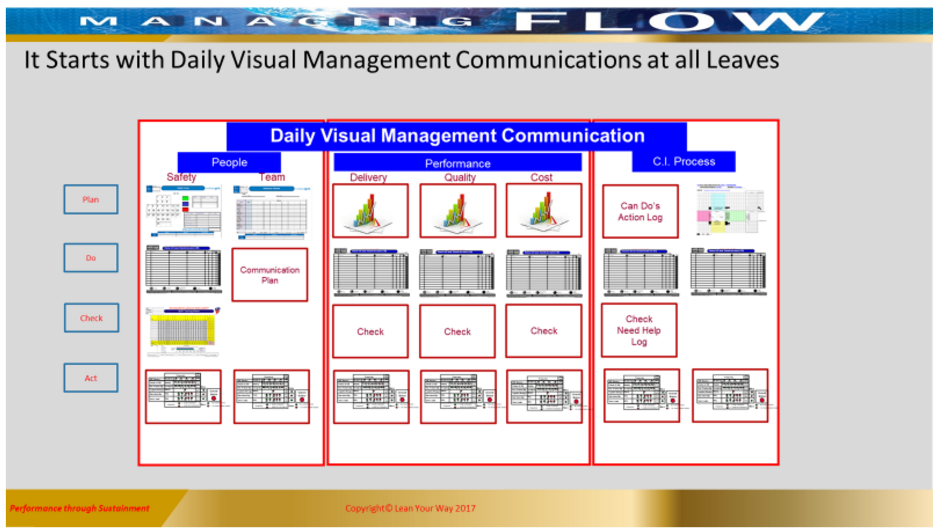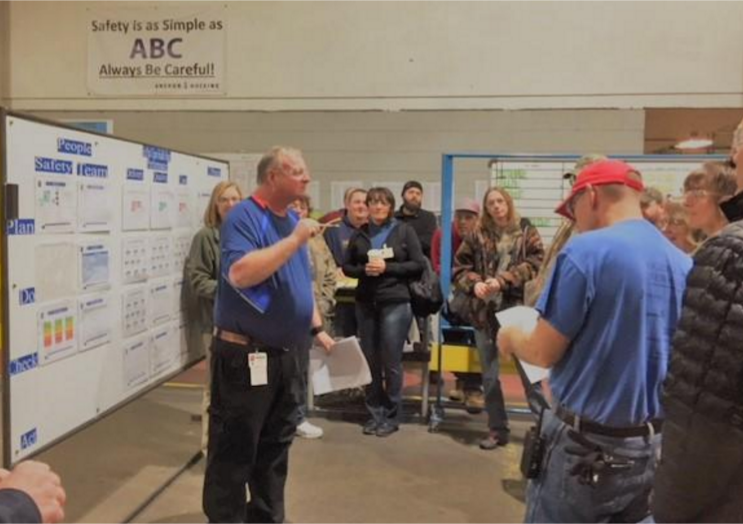“Show me someone who has done something worthwhile, and I’ll show you someone who has overcome adversity.“
– Lou Holtz
Visual management tool of Lean is a hot topic. Should it be a digital format or a white board work center in a company? Visual management is different than just having a TV monitor or whiteboard on display. In this post I would like to show you the basic principles of creating visual management that call your teams to action. There is more to visual management than recording data. It’s what you do with it versus merely putting graphs together.
Organizations have been working with daily management systems for many years, but Lean Daily Management systems have only recently been getting attention as a key tool of Lean. In the past, the emphasis has been on identifying waste and making rapid improvements quickly, but many organizations have experienced success followed by a lot of backsliding. One of the missing ingredients is Lean Daily Management leadership understanding what the conversation needs to be.
Visual Management done daily is what makes continuous improvement worth it. It helps make the daily continuous rapid improvement work sustainable. If there is no daily management meeting in place, there will not be a culture change or engaged employees. While there are several ways to implement Visual Daily Management, it is crucial that Daily Management includes a system that engages your employees versus just talking at them. One of the most important parts of Visual Daily Management is a huddle center. In this blog, we will talk about the basic elements of daily huddle center.
They all mean the same thing, but unless you speak Greek or Latin, the first two words may not have been clear.
“Status at a glance”
You have no doubt heard the term many times when discussing visual management and the fundamentals of Lean Huddles. What does it really mean, and how do we ensure that the tools we are implementing truly are telling the story our picture intends?
Manufacturing has focused on visual management for a long time, but how does it apply in every industry or company? The key objectives of visual daily management are
- Status at a glance (colors matter) Standard colors throughout the process. Blue for the target – Green = you made the target (Green is the representation of money) – Red = you missed the target
- From left to right 3 sections – People – Process – Process Improvement
- The left-side starts with People and were we safe yesterday. Then you address other People issues
- The center-section Process focus is Quality, Customer orders – Cost
- The right-side focus is on continuous improvement – the ideas your employees capture from the conversation at the “huddle” daily to create improvement daily
For a leader or coach, especially a leader in an organization that is on the pathway to a Lean transformation journey, visual management is one of the most fundamental and necessary elements to success daily. Going to Gemba daily is focused on coaching and reinforcing the behaviors of employees that support your objectives and measurements daily–which are driven by your strategic initiatives of what “good” looks like. Going to Gemba is about the team observation and your conversations and the ability to see the “status at a glance waste.”

The Daily Huddle
Let’s begin with defining a daily huddle meeting: a daily huddle is a stand-up meeting for 5 – 15 minutes to discuss status of yesterday’s results of operations, plan for the day, and status of problem-solving efforts to address issues.
What should happen in a Lean Daily Huddle? Typically, the team gathers around a visual management board (this typically includes metrics, problem solving, continuous improvement ideas, and process status/plan). While there are typically multiple tiers of huddle meetings, we will discuss the first tier in this blog. The first tier is the “front line” and typically happens at the beginning of the shift or shift changeover.
The visual management center clearly specified winning versus losing daily by the criteria for green and red. The coach or leader must be able to articulate the function of the board as well as the meaning for the employees. A visual management system throughout an organization is critical to the sustainability of your Lean Journey.
Once you get the process working well daily, maybe in some organizations you can create a digital center that works just like the layout presented in the blog. But I would share with you, more often than not, once you go digital most leaders stop having the daily huddles and the conversation of continuous improvement die at the vine. Daily visual management creates and sustains employee engagement.
I Implement Lean Manufacturing for Any Sized Project and AT Any Budget
If your organization can benefit from my expertise in assessing corporate culture, navigating organizational dynamics, and translating corporate strategies into tangible results for sustainable change, then you’ve come to the right place. I welcome the opportunity to get in touch for a preliminary analysis of your situation.



0 Comments